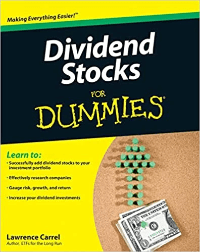DIVIDEND ARISTOCRATS
DIVIDEND ARISTOCRATS
A RELIABLE SOURCE OF INCOME?
If you are looking for a reliable source of income from your investments, you might want to consider the US Dividend Aristocrats. These are companies that have increased their dividends for at least 25 consecutive years, demonstrating their ability to generate consistent cash flows and reward their shareholders.
But before we get into the details, you might like to listen to this episode of the podcast.with Lawrence Carrel. He literally wrote the book, Dividend Stocks for Dummies! He recommends a strategy of reinvesting dividends so that they automate your investment growth over time. Understanding that company earnings (expressed as dividends) helps me to remain calm when markets are not. Earnings are far less volatile than the stock market.
“You might not think of investing when the market's down, but because the dividend reinvestment plan just keeps rolling along, you buy shares when the prices are cheap. And then of course, when the market goes up, you buy shares as they're going up. So it is dollar cost averaging and it takes a lot of the thought process out of it.”
The US dividend aristocrats are a group of more than 60 S&P 500 stocks that have raised their dividend payments each year for at least 25 consecutive years. They are considered to be reliable and stable sources of income for investors. Some of the most well-known names on the list are PepsiCo, Coca-Cola, Johnson & Johnson, McDonald's and Walmart.
According to Forbes, the 10 highest paying dividend aristocrats to outperform in 2023 are:
- AT&T (T) with a dividend yield of 7.6%
- Exxon Mobil (XOM) with a dividend yield of 6.2%
- Chevron (CVX) with a dividend yield of 5.4%
- AbbVie (ABBV) with a dividend yield of 4.9%
- Realty Income (O) with a dividend yield of 4.3%
- Cardinal Health (CAH) with a dividend yield of 3.9%
- Kimberly-Clark (KMB) with a dividend yield of 3.8%
- Leggett & Platt(LEG) with a dividend yield of 3.7%
- Walgreens Boots Alliance (WBA) with a dividend yield of 3.7%
- Caterpillar** (CAT) with a dividend yield of 3.6%
But be warned! Dividends are NOT guaranteed. According to Lawrence:
"When the market turns down and companies are suddenly in a cash crunch and they can't pay all their bills, the first thing they're going to cut is the dividend. Because there's immediate money that they've got in their pocket. And it's like, 'Well, why do I need to give it out to the shareholders when I need to pay this money off to pay my bills to keep the company going?' So dividends are not guaranteed, no matter how long it's going."
Another guest on the podcast was David Maurice Sharp. He's a dancer turned financial educator to the arts community. He believes that one of the biggest problems that artists face is not being provided with a pathway into the world of investing and figuring out how it can help to support the work that artists do.
"We talk about the dividend aristocrats because we're always with people that are, that have sort of fluctuating income. I always sort of emphasize income producing investments because they could provide a source of income in future, which is, is never a bad thing for people in the arts."
And before you say to me Phil, I'm not an artist, consider how many people work in the gig economy these days. Think about how dividends could help those lumpy earnings. Artists have lived like this for a long time and they are the original hustlers and pioneers of the gig economy.
CAN I BUY THE DIVIDEND ARISTROCRATS WITH AN ETF?
One of the easiest ways to invest in the dividend aristocrats is to buy an exchange-traded fund (ETF) that tracks them. An ETF is a collection of stocks that can be traded like a single stock on the market. There are several ETFs that focus on the dividend aristocrats, such as:
- The ProShares S&P 500 Dividend Aristocrats ETF (NOBL): This ETF tracks the S&P 500 Dividend Aristocrats Index, which includes all the companies in the S&P 500 that have raised their dividends for at least 25 years. It has 65 holdings, with an average yield of 2.3% and an expense ratio of 0.35%.
- The SPDR S&P Dividend ETF (SDY): This ETF tracks the S&P High Yield Dividend Aristocrats Index, which includes all the companies in the S&P Composite 1500 that have raised their dividends for at least 20 years. It has 119 holdings, with an average yield of 2.9% and an expense ratio of 0.35%.
- The Vanguard Dividend Appreciation ETF (VIG): This ETF tracks the NASDAQ US Dividend Achievers Select Index, which includes all the companies in the NASDAQ US Broad Dividend Achievers Index that have raised their dividends for at least 10 years. It has 211 holdings, with an average yield of 1.7% and an expense ratio of 0.06%.
Remember that when you own a stock, you own a part of the company. It's more than a ticker code on a screen. You own part of that business. Everyone from the board of directors down is working on your behalf. How cool is that!
Any advice in this blog post is general financial advice only and does not take into account your objectives, financial situation or needs. Because of that, you should consider if the advice is appropriate to you and your needs before acting on the information. If you do choose to buy a financial product read the PDS and TMD and obtain appropriate financial advice tailored to your needs. Finpods Pty Ltd & Philip Muscatello are authorised representatives of MoneySherpa Pty Ltd which holds financial services licence 451289. Here's a link to our Financial Services Guide.
Disclosure: The links provided are affiliate links. I will be paid a commission if you use this link to make a purchase. You will also usually receive a discount by using these links/coupon codes. I only recommend products and services that I use and trust myself or where I have interviewed and/or met the founders and have assured myself that they’re offering something of value.




